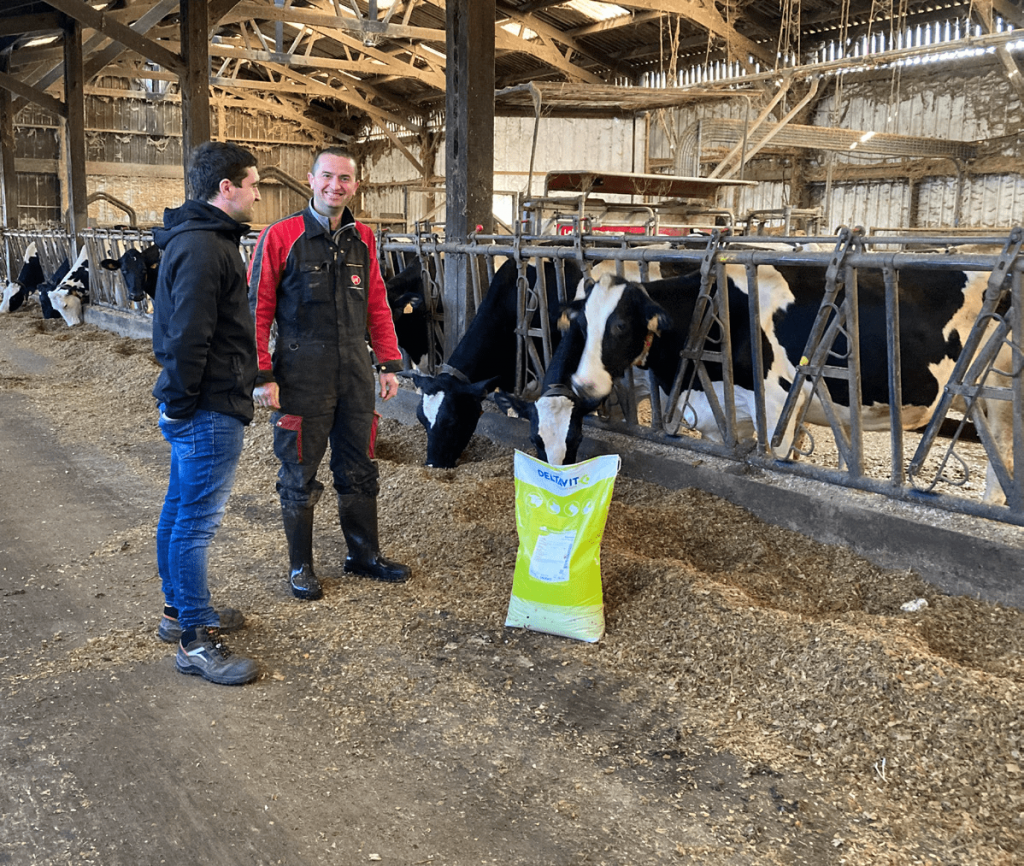It was while reading the Paysan Breton that the farmers discovered Thermo®Plus, the solution for ruminants against heat stress. They had been looking for some time for a solution to support their animals in order to reduce the impact of high heat on their herd of dairy cows (drop in milk, drop in ingestion, etc.). The purchase of fans was excluded as they were more expensive in terms of investment.
Thermo®Plus: tested and approved on dairy cows
The farmers therefore decided to test the Thermo®Plus solution on their dairy farm, which consists of about 130 dairy cows. The product is added directly to the ration.
In parallel, we immediately set up the Thermo®Tool application to predict heat peaks in advance, says Hamel.

The Thermo®Tool application
Thermo®Tool is a mobile application that forecasts heat stress levels (THI) up to 5 days ahead and sends alerts to users.
As soon as the application indicates an alert, the product is added to the ration 2-3 days before the heat peaks and 2-3 days after.
You have to continue a little bit after the heat episodes to help the cows recover, says Ms Hamel.

During the summer of 2022, SCEA Hamon Hamel distributed the Thermo®Plus solution over 4 periods:
- From 14 to 18 June
- From 10 to 21 July
- From 01 to 04 August
- From 09 to 14 August
Temperatures ranged from 28 to 38°.
Following this experience, they drew the first conclusions and concluded from their actions that they should not have stopped using the product between the last two hot periods.
Évolution de la production laitière lors de fortes chaleurs
| Date | Daily production (in litres) | Temperature reading |
| 09/08/2022 | 32.3 | |
| 10/08/2022 | 33 | |
| 11/08/2022 | 32 | 28° |
| 12/08/2022 | 32.7 | 31° |
| 13/08/2022 | 32.1 | 33° |
| 14/08/2022 | 31.6 |
The evolution of milk production over the months shows an average of 31.1L over 6 months. The results are clear. The farmers saw an immediate effect on the animals.
Overall, there has been less milk drop compared to last year and the animals are recovering faster, says Mr Hamon.
We have seen a positive effect of the product on animals:
- Better salivation
- More urine
- Calmer breathing: “It pulls less on the sides!
Mr Hamon and Ms Hamel particularly appreciate the very visible effects of the product.

Improved reproduction with Thermo®Plus
Summer is a difficult time for us regarding reproduction. Reducing heat stress helps to improve reproductive performance.
Thermo®Plus: the outlook for summer 2023
We took Thermo®Plus to try it out. Following the results, we continued and will try again in 2023. We still have 2 bags from last year that we will be able to use again in 2023 because the expiry date* is good. To support the animals, it is important to anticipate periods of stress. The farm has chosen to always have 1 or 2 bags in advance. This allows us to anticipate peaks and avoid product shortages, especially at weekends.
As the SCEA Hamon Hamel is located in an area that does not suffer from heat waves, they will continue to work with the Thermo®Tool application in order to manage heat peaks on their farm.
Thermo®Tool is an indispensable tool for us, a real help. Thermo®Plus, a real support for our dairy cows.
* The shelf life of the product is 18 months, i.e. 2 seasons.
Information on dairy farming
SCEA Hamon Hamel
- 2 partners
- 130 VL (Prim Holstein) – 9500L
- 2 Lely robots – mattress stalls
- Maize silage ration
- No grazing
Heat stress in dairy cows
Heat stress in dairy cows is a concern for farmers. Cows are particularly sensitive to temperature variations and can be affected by excessive heat or cold.
Heat stress can cause health problems such as respiratory problems, reduced milk production, weight loss and reduced fertility. To prevent heat stress in dairy cows, it is important to provide a suitable environment with adequate ventilation, sufficient fresh water and a balanced diet. Farmers should also carefully monitor weather conditions and take measures to protect their cows during periods of extreme temperatures.
Are you interested in the Thermo®Plus solution for your dairy cows?



